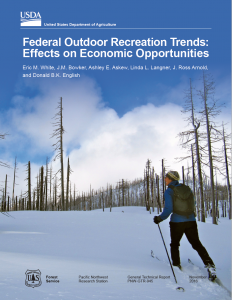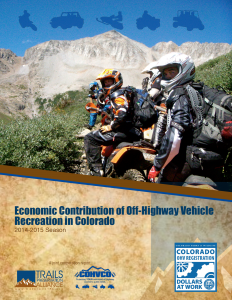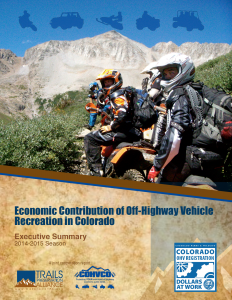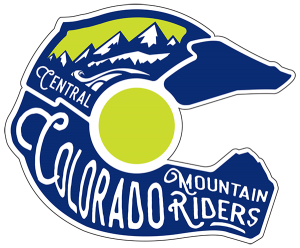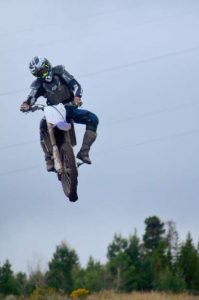Summit Daily
by Phil Lindeman
10/28/16
Article: www.summitdaily.com/news/sports/summit-locals-work-to-create-ohv-trail-system/
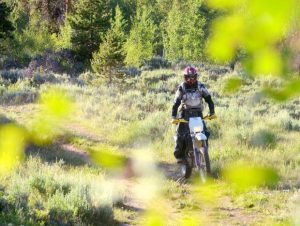
photo: Phil Lindeman / plindeman@summitdaily.com | Tim Nixon of Summit County Off-Road Riders on a trail in the Frisco area. The president of the nonprofit hasn’t ridden his motorcycle in the area for at least a year and recently discovered a favorite trail of his was closed to moto travel.
It’s a tale as old as trails. For decades, mountain bikers and off-highway vehicle users have shared more than 430 miles of sanctioned dirt road and singletrack in Summit County. The two groups have had occasional conflicts over the years, but in 2011, when the U.S. Forest Service released the final version of a decade-long travel management plan, the OHV community lost access to nearly 400 miles of trail — the same routes they’ve ridden since the ’70s.
“When we started this inventory process, we had zero miles of OHV singletrack in the system and just five miles of ATV road with the Strait Creek Trail,” Ken Waugh, a recreation officer with the Dillon Ranger District since 2003, said. “We had nothing here, so everything out there was user created. With the travel management plan, we said that everything had to stop. Nothing was open.”
For Waugh and the U.S. Forest Service, the travel management plan was the first step in building a reliable and sustainable trail system in Summit County. For OHV users, the crackdown on access and aging social trails felt like a slap in the face. Suddenly, it seemed, ATVs, four-wheelers and motorcycles were no longer allowed to use the same outdoor playground that hikers, bikers and cross-country skiers enjoy throughout the year…
“I think they (the motorized community) get a lot of misplaced anger with their impact, but for the two-wheeled economy, they put more money, arguably, than anything but hunting and fishing with hunting and fishing licenses,” said Luis Benitez, director of the department. “And that’s something to celebrate — they take care of their own ecosystem.”
The new study, conducted by Pinyon Environmental of Lakewood, is an updated version of a 2001 study that showed an economic impact of $338 million. In 15 years, the industry’s economic heft has quadrupled — just as local access disappeared.
“For the most part, it seems that motorcycle riders are looking for that backyard experience,” Waugh said. “They might travel, but our local users are staying here, and that’s what they’re looking for. It’s the same thing with hikers and mountain bikers — people want to go on the trails near their house for an afternoon or an evening ride. When you have to go out of the county to find that opportunity, it’s not convenient. It’s not local.”
The Tenderfoot Mountain project
In response to the travel management plan, a local OHV group, Summit County Off-Road Riders, approached the ranger district to find something — anything — they could call their own. Users like Tim Nixon, president of SCORR, and Don Riggle, director of operations for Trails Preservation Alliance of Colorado Springs, remember how many modern-day trails were forged by OHV users. Motorcycle riders cleared Breckenridge routes like Humbug Hill, French Gulch and the Swan River area in the ’70s and ’80s, Riggle said, only to see them closed with the travel management plan.
“People who are new to the sport of mountain biking need to look back and see that OHV riders did most of the early work back there in the ’70s,” said Riggle, whose organization advocates for OHV users across the state. “I remember clearing those areas of wood and nails, making it so you can go through without getting a flat tire, and now we’re totally kicked out of that.”
As access in Breckenridge disappeared, SCORR and the ranger district identified two areas for OHV-friendly travel: the Golden Horseshoe area of Breckenridge, now home to 11 miles of OHV trails, and the brand-new Tenderfoot Mountain system between Dillon and Keystone, home to 21 miles of brand-new trail connected to fives miles of dirt road at Straight Creek.
“They said, ‘If you let us close trails in Breckenridge, we will open more in Tenderfoot,’” Nixon said. “And they’ve kept their word. Because they were closing trails, I never imagined they would be building new trails for motorized use.”
The first hurdle: funding. In 2013, SCORR won a state grant to conduct an environmental assessment of Waugh’s plans for Tenderfoot. That was approved in November 2013 and kick-started the project.
“This was a compromise, and you know how it is with compromise — not everyone gets what they want,” Waugh said of the approval process, which included public input from residents who wanted the area closed off to OHV travel. “The motorized users lost a lot of miles of trail — they also now have seasonal restrictions — so they were happy for a trail system, but not everything they wanted.”
Billion-dollar industry
After approval, SCORR ramped up efforts to attract volunteers for trail crews, while Waugh and the ranger district started looking at the bottom line.
In Colorado, all OHV users pay a $25.25 annual tag fee, which contributes roughly $4.5 million annually to trail projects across the state. The Dillon Ranger District has also received $500,000 from the state OHV Grant Fund since 2014, district officers said, including $114,000 in 2016 to provide a four-person trail crew for Tenderfoot and a two-person OHV crew for the entire district. This additional revenue stream from increased OHV use came just as funding for ranger districts across the nation was shrinking: In the past five to 10 years, the White River National Forest budget was slashed by about 40 percent, officials said.
“We’re always looking for alternative funding sources,” Bill Jackson, district ranger with the Dillon Ranger District, said. “We’re looking for partners, for grants, and the OHV fund has been a great way to help approved projects continue moving forward.”
The $114,000 in 2016 gave the Tenderfoot project groundwork, but it didn’t come close to supplying the manpower needed for 21 miles of new and refurbished trails. That’s where SCORR came back into the picture with volunteers and additional grant funding. Construction on three new trails in the Frey Gulch and Tenderfoot areas — Moab-Knobby, Powerline Loop and Seven of Nine — started this summer.
“We have the cooperation of the Forest Service, we have people designing the trails, we have a nonprofit status to get grants, and we know there are people out riding,” Nixon said. “What we don’t have are people who will show up to do the work. I’ve found that to be very rewarding. It adds depth to my sport, to have a community on a hillside working for the same cause.”
Nixon, Riggle and others in the OHV community hope this public showing of support for multi-use trails across the state can lead to improved access. More importantly, they hope it mends the wounds caused by decades of tension between motorized and non-motorized trail users.
“On the weekends it can be crowded out there,” Nixon said. “I don’t think it (moto use) is declining at all, but the problem is that we’re putting more people on less terrain with these closed trails. Building these new trails is helping us keep up with demand. Eventually there will be a breaking point, but the door up here will always be open.”
Save
Save


